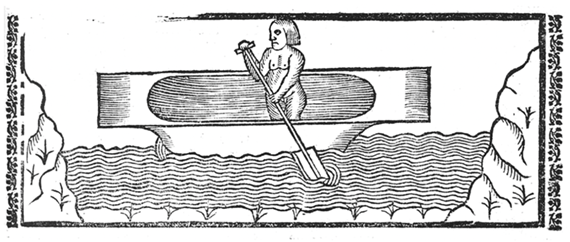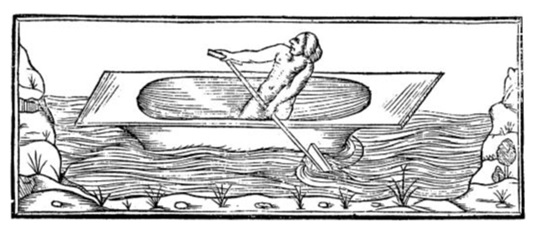2 Prints of a Sole Amerindian in a Canoe


Annotation
These images of a man in a canoe come from the work of the Spanish official, historian, and botanist Gonzalo Fernandez de Oviedo (1478-1557), who created many images of Amerindians while he was in the Caribbean during the 1520s. He used his powers of observation to create a detailed record of the peoples, plants, animals, and activities he encountered during his journey, including Amerindian peoples actively engaged in canoeing. In the woodcut from 1535, we can pick out key aspects of seafaring practice. We can see that the canoer is facing forward, in contrast to European rowing, in which oarsmen face backward. We can see that they are paddling the canoe alone, indicating that these vessels may have been used for both long or short voyages. The paddle was gripped with one hand on the top bar and the other on the shaft, just as today’s canoe paddles are. This woodcut tells us canoers looked forward, towards where they were heading, which could inform modern computational modelers about factors in how the vessel was piloted in the water and how it would have engaged with currents.
This image was revised for the 1547 publication of the work, making the landscape and seascape more detailed and changing the Amerindian inside the canoe. The change in the sea's surface as it interacts with the paddle could indicate different flows of current, or how paddles were used to either push into or against the force of the water. The change in stance of the canoer seems to indicate that they are using the paddle more like the pole of a punt than an actual canoe paddle. It seems likely to me, however, that the first image drawn by someone on the ground would bear a closer representation to reality than the later copy, likely redone by someone who had never traveled to the Caribbean.
This change in image can alter our understanding of how these canoes were used in their environment, and perhaps even bring into question the usefulness of images like this for our purposes altogether. When considering historical works, it is important to consider not only who and what is depicted in an image, but who created the image. For the purposes of learning about canoe use and past boat construction in the pre-Columbian Caribbean, there may be some elements we can take from these drawings to influence our thinking. However, we must make sure we are using sources created by those most likely to have had direct contact with the peoples in question.
This source is part of the Caribbean Seafaring in the Archaic Age teaching module.
Credits
Oviedo, Historia general de las Indias (Seville, 1535) (Huntington Library)
Oviedo, Historia general de las Indias (Salamanca, 1547) (Huntington Library)